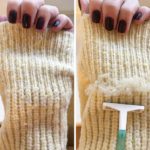If you are not careful when washing clothes, many situations can arise that can make you cry or laugh. Therefore, equipping yourself with some ways to handle laundry issues is essential for anyone.
How to Handle Laundry Issues
Here are some problems you may encounter during the laundry process and how to fix and prevent them.
Shrunken Wool Clothes
If your favorite wool sweater shrinks after washing, you definitely washed it incorrectly, like using too hot water or running the dryer on a high heat cycle.
Although there is no surefire way to bring shrunken wool garments back to their original size, you can still try. In some cases, shrunk clothes can still be restored to their original shape.
You can soak the wool clothes in warm water with baby shampoo or conditioner for 30 minutes; then take it out, lay it on a clean surface, and stretch it by hand. You continue stretching from all directions for 15-20 minutes. This method can restore clothes to a certain extent.
Clothes Stuck with Paper Lint
This is a common problem when clothes are washed with some leftover paper in the bag. After washing, the pieces of lint are scattered everywhere and stick to your clothes. When the clothes are taken out of the machine, the paper lint sticks on and looks very dirty.
The best way to handle this laundry issue is to air dry the clothes first, remove the remaining residue, and use a lint roller to clean the rest. This is why you should check the pockets before putting clothes in the washing machine.
Faded Clothes

It’s frustrating when one of your garments fades and transfers onto other clothes in the machine, turning all the freshly washed clothes into a mess. To remove the color bleeding on clothes, you can wash them multiple times. If the stain persists, you can use stain remover, vinegar, or pre-made stain removers depending on the type of fabric.
By taking a few preventive and corrective measures below, you will never encounter a similar situation:
– Read the garment care instructions: Manufacturers usually print warnings about color bleeding on the care label. If there are any such warnings, you should wash those clothes separately.
– Check if the clothes bleed: You can take a cotton swab or small piece of fabric, dip it into liquid detergent, and gently rub it on the clothes. If there is detergent residue, you can mix one teaspoon of detergent with two tablespoons of water to perform this test. If you see color bleeding on the cotton swab or small piece of fabric, the garment is prone to color bleeding and should be washed separately.
– Use color bleeding prevention products: There are some products on the market that prevent color bleeding on clothes. You can use them to help your clothes stay vibrant.
– Separate light-colored and dark-colored clothes: Dark-colored clothes are often prone to color bleeding. Therefore, separate them from white and light-colored clothes before washing.
– Do not leave wet clothes in the washing machine: Take clean clothes out of the washing machine immediately after the wash cycle ends.
Faded Clothes
Many types of clothes tend to noticeably fade when washed. Using hot water and harsh chemicals in the washing machine accelerates this condition. These substances negatively affect the color of the fabric, causing it to fade. Therefore, you should carefully choose gentle laundry detergents by reading their ingredients.
Although you cannot restore the color of faded clothes, you can limit color fading on other clothes by following these ways:
– Only use hot water when recommended on the care label.
– Do not over-dry clothes in the dryer or expose them to sunlight for too long.
– Try washing clothes on a gentle cycle.
– Avoid using strong laundry detergents.
Clothes Covered in Detergent Residue
Some people have a habit of using more laundry detergent with the thought that it will clean clothes faster. However, this is not true at all. Using more laundry detergent than the recommended limit will leave soap residue on clothes, especially dark-colored and dark-toned clothing. It leaves a dingy appearance and irritates the skin.
To prevent this situation, you should measure the appropriate amount of laundry detergent and add it to the washing machine. The best way to handle this laundry issue is to rewash the clothes thoroughly.
Excessive Wrinkling
The main cause of wrinkles is when the washing machine is overloaded. When you pack the drum too tightly, the clothes move as a bloc. The pressure inside the drum increases, especially when the machine spins at high speed, causing wrinkles.
The simple way to prevent this common laundry issue is to avoid overloading the washing machine. Remember that clothes need enough space to move freely inside the drum.
Torn Clothes While Washing
There are several reasons why your clothes may tear during washing:
– Using too much chlorine bleach or not diluting it properly weakens the fabric and causes holes.
– The decorative details of a garment may rub against other clothes and create holes.
– The zippers and buttons of clothes can rub against the fabric, causing holes.
What you can do to avoid this issue is to always fasten all zippers and buttons before putting the laundry into the machine. While sorting laundry, make sure to separate clothes with embellishments like sequins, beads, etc., so they do not damage other clothes. Always dilute the chlorine bleach before using it in the washing machine.
According to VTC
Clothes Using Household Items For Free’>8 Clever Ways to Straighten Clothes Using Household Items For Free
The Small But Mighty Button on the Washing Machine: Unlocking Cost-Saving Secrets for Millions a Year
Having a washing machine with a cleaning function is essential for maintaining cleanliness and saving time and money. By knowing how to properly use it, the machine will stay clean and efficient, ensuring optimal performance. With this feature, you can easily keep your washing machine in top condition, ensuring clean and fresh laundry every time.



































